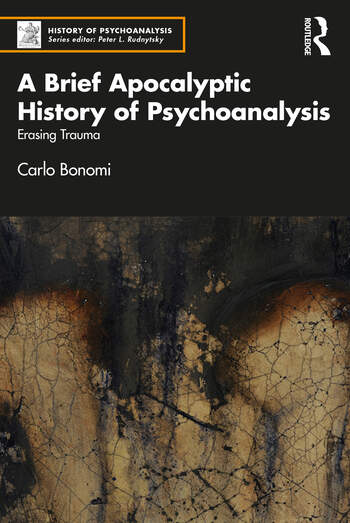A Brief History of Psychoanalysis - psicologo Firenze
Menu principale:
A Brief History of Psychoanalysis
IL TRAUMA CANCELLATO
Bonomi, C. (2023). A Brief Apocalyptic History of Psychoanalysis. Erasing Trauma. London & New York: Routledge.
A Brief Apocalyptic History of Psychoanalysis returns us to the birth of psychoanalysis and the trauma of castration that is its umbilicus. The story told in this book centers on the genital mutilation endured in her childhood by Emma Eckstein, Freud’s most important patient in his abandonment of the “seduction theory.” For both cultural and personal reasons, Freud could not recognize the traumatic nature of this “Beschneidung” (circumcision), which nevertheless aroused in him deep anguish, conflating his own circumcision, the echoes of a violently anti-Semitic environment, and conflicts with his father. Taking Freud’s countertransference to Eckstein’s trauma into account leads to a radically different understanding of the origins of psychoanalysis from the one based on the solipsistic perspective of his self-analysis. Carlo Bonomi argues that the unacknowledged trauma of circumcision was inscribed in Freud’s system of thinking as an amputated legacy from which the dreams and fantasies of his closest disciples would germinate and bloom. In particular, Sándor Ferenczi, Freud’s pupil and confidant, would help to restore this wounded body, thereby laying a new foundation for psychoanalytic theory and practice. Bonomi’s “apocalyptic” narrative will expand the conceptual horizons of psychoanalysts and psychoanalytic psychotherapists, historians of psychoanalysis, and scholars of both gender studies and Jewish studies.

INTRODUCTION
In his memorable book on the psychoanalytic meaning of history, Norman O. Brown said that “The aim of psychoanalysis—still unfulfilled, and still only half-conscious—is to return our souls to our bodies” (Brown, 1959, p. 158). This simple sentence neatly captures what this book means to me.
The story told in this book is based on an event that has remained hidden until now. Taking it into account leads to a completely different narration of the foundation of psychoanalysis than Freud's and, above all, a different paradigm from the one inherited from self-analysis.
This event is nothing less than a circumcision, "Beschneidung", endured in her childhood by a patient who, during the dawning of psychoanalysis, inspired Freud’s ideas, inhabited his dreams, elicited his sudden turns and, eventually inspired the self-analysis from which Freud’s masterwork, The Interpretation of Dreams, unfolds. ... DOWNLOAD THE INTRODUCTION
INTRODUZIONE
“Lo scopo della psicoanalisi – ancora incompiuto e ancora solo per metà conscio – è di restituire l’anima al corpo …” (Norman O. Brown, Life Against Death: The Psychoanalytic Meaning of History, 1959, p. 158; trad. it. p. 204)
La storia raccontata in questo libro si basa su un fatto che è rimasto fino ad ora nascosto. Tenerne conto porta a una narrazione completamente diversa della fondazione della psicoanalisi rispetto a quella di Freud e, soprattutto, a un paradigma diverso da quello ereditato dall'autoanalisi.
Questo fatto non è altro che una circoncisione, “Beschneidung”, subita da bambina dalla paziente che negli anni in cui nasce la psicoanalisi ispirò le idee e i sogni di Freud, come pure le sue svolte repentine, fino a suscitare quell’autoanalisi da cui ha preso forma il capolavoro de L’interpretazione dei sogni. .... SCARICA L'INTRODUZIONE